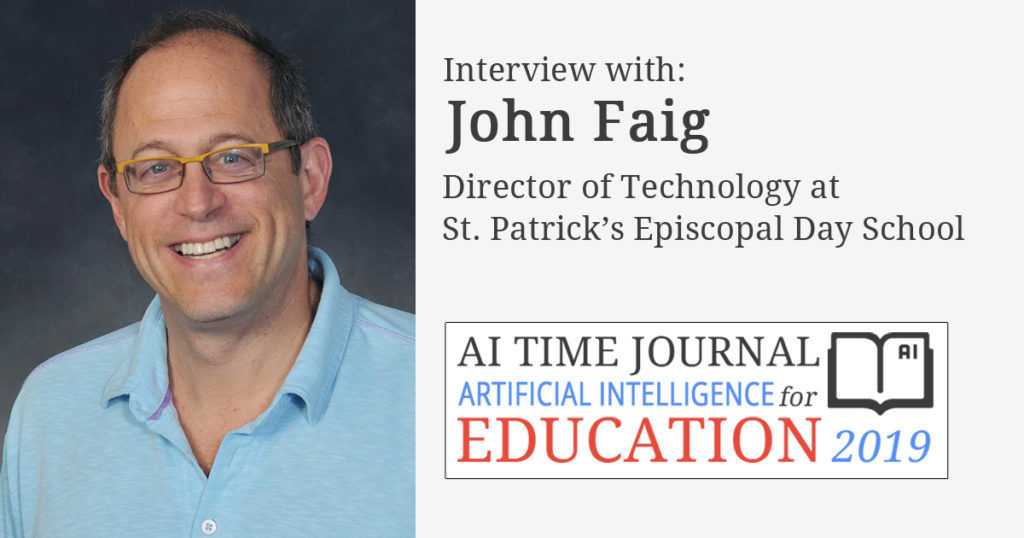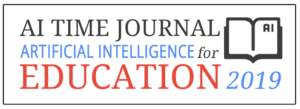
Mr. Faig is Director of Technology at St. Patrick’s Episcopal Day School in Washington, DC. He is interested in educational reforms that enhance learning environments for students and the role of Artificial Intelligence.
In this interview, Mr. Faig shares his views and analysis on the current challenges in the educational system, the opportunities brought by AI in this sector, and future trends in AI and education.
This interview has been
featured in the AI for Education Initiative 2019.

What are the major challenges in the educational system today? How can AI technology help solve or mitigate them?
The major challenges in education are for teachers to effectively teach an increasingly diverse group of students. This means building solid relationships with each student and fostering growth in non-traditional academic skills, such as social-emotional and metacognitive skills. Overcoming these challenges requires teachers to use less of their time for administrative tasks and more of their time for assisting students, providing feedback, and tailoring the curriculum and pedagogy to each student.
Artificial intelligence has the potential to significantly help teachers with their challenges. Understanding how each student learns best is a massive data crunching exercise. Teachers absorb this type of information through the grading process and working with students, but AI will provide additional insights. An AI-based teaching assistant could relieve some of the administrative burdens that limit the amount of annual time spent on teaching to about 50% worldwide.
What are the major opportunities brought by AI in Education today?
Today, AI adoption is in its infancy with more adoption in industries other than education. This is likely due to a more competitive landscape, larger investments in information technology and a general willingness to try new ideas. At the same time, education is grappling with understanding the return on investment of the educational technology products used in classrooms. The results so far are not very favorable and this may cast a pall over more investments in cutting edge technologies like AI.. b. AI eats data for breakfast and this has incredible potential as it will lead to more dynamic scope and sequences. Currently, teachers and schools do little or no analysis of alternative curriculums, content or pedagogies (knowns as A/B testing). Imagine AI analyzing student work along with textbooks and curricular materials and identifying the best set of instructional resources for each student? What content best illuminates a concept? What parts of the current curriculum should be deemphasized or eliminated?
Imagine AI analyzing student work along with textbooks and curricular materials and identifying the best set of instructional resources for each student?
How can teachers prepare for an AI-powered education?
Schools should lay the groundwork for AI by beefing up their information systems to increase the amount of data available to train an AI system. Currently, the data is more summative in nature, such as attendance and disciplinary data, grades and comments, and standardized testing information. In order for AI to personalize the learning paths for students, there needs to be more transient metadata about student learning journeys. That is, how students are progressing on learning goals? What affordances and interventions are boosting achievement? What instructional techniques and technology products are improving time efficiency? b. One potential explanation for educational technology products having minimal impact on student achievement stems from the fact that teachers may not be using the product effectively or may not have ratcheted up the complexity of their curriculum accordingly. If the current generation of automation did not find a snug fit in classrooms, then a more advanced generation – AI – may likewise not find a suitable home. c. Teachers should also begin to review their pedagogy and unpack their curriculum to make “room” for AI. AI will offer natural language interfaces to content and school information systems. Natural language will evolve to support translations services that provide access to content in other languages. Translation services will not be limited to words only as AI will be able to provide multiple perspectives of controversial topics and different viewpoints. AI may also be able to avoid the “curse of knowledge” where teachers with advanced domain knowledge are sometimes unable to translate that into how novices (e.g., various grade levels) perceive the material and how it should best be presented.
Which AI technology do you think will have the biggest impact in Education in the coming years, and why?
I see the applicability of all AI technologies in education. For example, we know a lot about how the cognitive processes of the brain and how it learns best. At the same time, John Haitte has illuminated the factors that impact learning. Imagine an adaptive learning system that takes into account the cognitive ability of each student along with their likes and dislikes and various instructional and environmental considerations. You will have a very engaging and efficient learning environment. Some adaptive learning will be built into all EdTech products to ensure it is helping students learn faster or explore more deeply. Natural language interfaces could be used to power domain-specific chatbots. Real-time discussions are one of the few areas that are not automated as part of online courses. Imagine students interacting with a chatbot specifically set up to facilitate discussions around an essential question like the causes of World War. The chatbot would be adaptive and purposely not allow students to get answers to questions that they derive on their own.
Imagine students interacting with a chatbot specifically set up to facilitate discussions around an essential question like the causes of World War
How should educational system management software adapt for the advent of AI?
Educational information systems will need to prepare for AI by broadening their data and opening their systems via APIs. AI can’t analyze anything without data, so schools need to collect more data individual students and the overall school climate. APIs will enable information systems to share with other information systems and prepare to integrate with the major AI platforms from companies like Amazon, Google, IBM, Microsoft, and others. b. Educational systems will need to be made more dynamic to support AI’s more dynamic management of each student’s zone of proximal development. AI will provide enhanced decision making when it comes to matching content and pedagogy to each students. It will identify relevant and appropriate content based on student sophistication and the context required to develop understanding for transference. It will determine the most efficient way for each student to learn essential content and foundational skills. It will push students to deepen their understanding and tap into personal interests for side journeys.
Do you see threats of inequality in the access to AI-powered education?
AI will likely worsen the inequity between schools, much the same way as the use of educational technology. Schools with fewer resources will not be able to afford the specialized systems and hire the scarce expertise that AI will require.
What are the current technological limitations of AI which, once overcome, could bring massive improvements to the educational system?
With the availability of more student data, AI will eventually become master teachers. AI has a leg up on human teachers because human teachers require many years of schooling to become a teacher. Unlike teachers, AI is not “born” into generations. It is built and continues to evolve timelessly. Along the way, AI will understand how students learn best and, in turn, understand how the human brain learns and expands, which is the transfer of fundamental skills and knowledge into new situations. A detailed understanding of learning could pave the way for AI-based master teachers.
Unlike teachers, AI is not “born” into generations. It is built and continues to evolve timelessly.
What do you think are the biggest obstacles to applying AI in the educational system?
AI will face the same obstacles that innovations face trying to take root in education. The first is that schools need a visionary leader that understands the potential of AI and can create enthusiasm for its adoption. The next challenge is implementation, which is a challenge for schools. Even proven best practices rarely can be transferred and successfully implemented at other schools. The last challenge is usage and professional development. Teachers will need significant PD and time to understand how to use AI teacher knowledge of AI and support to help them to integrate it into their curriculum.
Where do you see AI for education in the next 5-10 years?
AI is a leading-edge technology that will likely find successes in other industries initially. The impact and broad usage of AI will likely be closer to 10 years than over the next few years, Educators are now just embracing basic educational technology broadly. AI tools will find adoption in other industries first, where its use can have an immediate impact on products and services and profits. Educational technology vendors will learn from other industries and build AI into their products. The gating factor for adoption will be the significant training and instructional design effort required to help integrate AI into teacher practices and their curriculum. The potential accelerant would be competition. If public and private schools are forced to compete more aggressively on learning effectiveness measures, then they will likely try and use more AI sooner…
